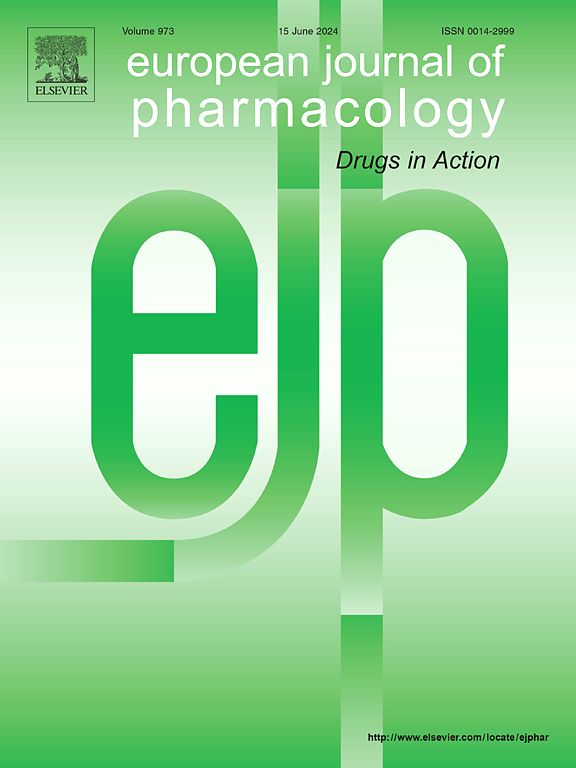迷迭香酸减轻血脑屏障功能障碍,改善小鼠脑缺血再灌注损伤
IF 4.2
3区 医学
Q1 PHARMACOLOGY & PHARMACY
引用次数: 0
摘要
脑缺血/再灌注(CI/R)对缺血性脑卒中有不利影响。这明显会引发血脑屏障(BBB)的破坏。迷迭香酸(RosA)以其提供神经保护的能力而闻名,是Lamiaceae植物家族中的一种酚酸化合物。然而,RosA对CI/R的神经保护作用与其对血脑屏障的直接保护作用之间的相关性尚不清楚。本研究旨在探讨RosA对小鼠CI/R损伤后血脑屏障完整性的调节作用,并探讨其潜在的药理机制。方法建立小鼠大脑中动脉闭塞(MCAO)模型,缺血1 h,再灌注24 h。随后评估神经评分、梗死面积、血脑屏障通透性、组织学检查和生化参数。结果RosA通过保护血脑屏障通透性,减轻CI/ r诱导的神经元损失和凋亡,改善脑功能,减小梗死面积。分子对接、分子动力学(MD)模拟和表面等离子体共振(SPR)表明,RosA可能直接结合基质金属蛋白酶-9 (MMP-9)和基质金属蛋白酶-2 (MMP-2)。此外,RosA显著增强了紧密连接蛋白,包括zonula occluden -1 (ZO-1)、occludin和claudin 5,同时降低了MMP-9和MMP-2 mRNA和蛋白的水平。结论RosA通过提高紧密连接蛋白表达,下调MMP-9和MMP-2水平,显著减轻了CI/ r诱导的大脑中动脉闭塞(MCAO)小鼠血脑屏障破坏。本文章由计算机程序翻译,如有差异,请以英文原文为准。
Rosmarinic acid attenuates blood-brain barrier dysfunction to improve cerebral ischemia/reperfusion injury in mice
Background
Cerebral ischemia/reperfusion (CI/R) has detrimental effects in cases of ischemic stroke. This notably triggers the blood-brain-barrier (BBB) to break. Known for its ability to provide neuroprotective benefits, rosmarinic acid (RosA) is a phenolic acid compound in the Lamiaceae family of plants. However, the relevance between the neuroprotective effect of RosA on CI/R and its direct protective effect on the BBB remains unclear. This study aimed to investigate how RosA regulates BBB integrity after CI/R injury and explore its underlying pharmacological mechanism in mice.
Methods
The mouse model of middle cerebral artery occlusion (MCAO) was established by subjecting the animals to 1 h of ischemia followed by a 24-h reperfusion period. Neurological scoring, infarct size, BBB permeability, histological examination, and biochemical parameters were subsequently assessed.
Results
Our study showed that RosA improved neurofunction and reduced infarct size by protecting BBB permeability, alleviating CI/R-induced neuronal loss and apoptosis. Molecular docking, molecular dynamics (MD) simulationand surface plasmon resonance (SPR) suggested that RosA may directly bind to matrix metalloproteinase-9 (MMP-9) and matrix metalloproteinase-2 (MMP-2). Furthermore, RosA significantly enhanced tight junction proteins, including zonula occludens-1 (ZO-1), occludin and claudin 5, while simultaneously decreasing the levels of MMP-9 and MMP-2 mRNA and proteins.
Conclusion
Our findings reveal that RosA significantly mitigates CI/R-induced BBB disruption in middle cerebral artery occlusion (MCAO) mice by enhancing tight junction protein expression and down-regulating MMP-9 and MMP-2 levels.
求助全文
通过发布文献求助,成功后即可免费获取论文全文。
去求助
来源期刊
CiteScore
9.00
自引率
0.00%
发文量
572
审稿时长
34 days
期刊介绍:
The European Journal of Pharmacology publishes research papers covering all aspects of experimental pharmacology with focus on the mechanism of action of structurally identified compounds affecting biological systems.
The scope includes:
Behavioural pharmacology
Neuropharmacology and analgesia
Cardiovascular pharmacology
Pulmonary, gastrointestinal and urogenital pharmacology
Endocrine pharmacology
Immunopharmacology and inflammation
Molecular and cellular pharmacology
Regenerative pharmacology
Biologicals and biotherapeutics
Translational pharmacology
Nutriceutical pharmacology.

 求助内容:
求助内容: 应助结果提醒方式:
应助结果提醒方式:


